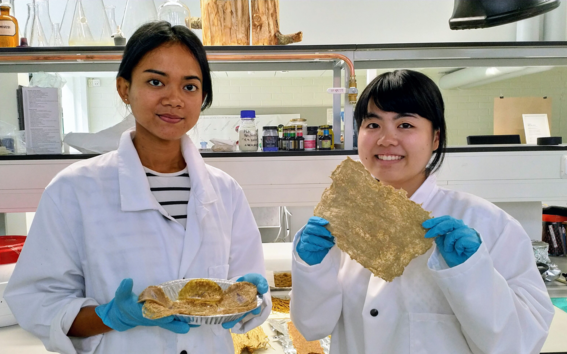What happens when you mix cellulose with wool or rice straw? CHEMARTS students spent the summer finding out

Some students spend their summers in an office; others use their downtime to travel the world. Rather than leaving campus for other sights this year, a diverse group of young minds opted to grab lab coats instead—in the name of sustainability.
Taking first steps towards new materials
‘I have always loved wool but I never knew that it could be blended with cellulose to make such a strong composite material,’ says student Surabhi Nadig, who studies creative sustainability.
Nadig is one of the students in this year’s CHEMARTS summer school, which mixes know-how from two areas—chemical engineering, and art and design—with the freedom to test ideas out. Like many of her peers, Nadig has focused on making use of a material that could otherwise end up in landfills. The wool used in her project, for example, was donated because it had no other use; by mixing it with cellulose, one of the most plentiful materials found in nature, she managed to create a durable yet flexible composite fabric.
The main highlight of the course for many is having the space and time to see how biomaterials interact under different conditions. Through their time in the laboratory, students developed first-hand understanding of what it means to mix various biomaterials with cellulose, providing a new angle to their main studies.
‘I never thought about the circular economy before this class. It’s really game changing—designers need to learn about materials,’ shares student Talisa Dwiyani.
Product-geared biomaterials
While a few of the students have concentrated on creating a strong, sustainable composite material with various applications, others have used the labtime to experiment with ingredients for a specific end use, like a fully biodegradable material that can be used in clothing or a lampshade made with rice straw.
When Tito Williams II, a student of collaborative and industrial design, started the course, he wanted to challenge himself by learning to colour bioplastics like polylactic acid (PLA) and cellulose acetate in fresh ways.
‘I want to make the first acetate glasses made with biopigments, colours that derive from the natural world,’ Williams explains.
Over the summer, he found ways to extract colour from turmeric, chlorophyll and beetroot to tint the durable material. He is now converting the yellow, olive green and pink pellets into filament for 3D printing, while working on a design prototype for his glasses.
‘I would love to one day develop this into a business,’ he says.
If Williams or others bring their work to that stage, they will be in good company. One of last year’s summer school participants recently launched her own natural make-up line—immediately selling out.
In the meantime, the innovative work developed in this year’s CHEMARTS summer school will be presented on today, August 24 at 12-16, at Haukilahti Upper Secondary School (Tekniikantie 3). The event is open to all.
- Published:
- Updated:
Read more news

Teamwork First-Aid Kit supports students in project-based courses
This online resource offers tools to support student teams throughout project courses.
Aalto ARTS alum Vidha Samya’s artwork featured at the Venice Biennale 2024
The Pavilion of Finland presents ‘The pleasures we choose’ at the 60th International Art Exhibition – La Biennale di Venezia until 24 November 2024.
IoT Forge donates EUR 1 million to the School of Engineering
The donation will be used for research and education on the Industrial Internet and digital twins.